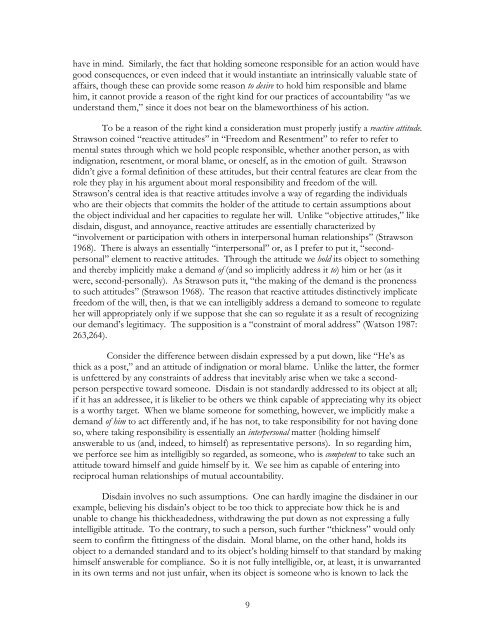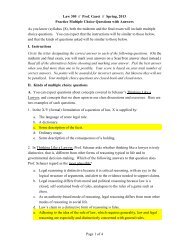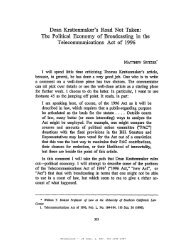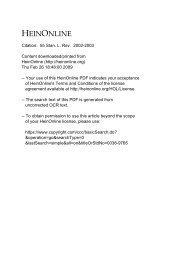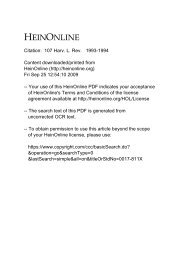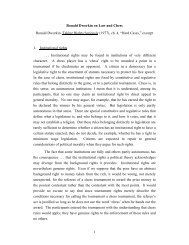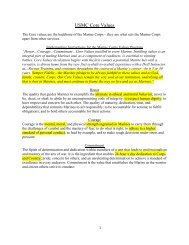1 MORALITY AND PRINCIPLE Jonathan Dancy is largely ...
1 MORALITY AND PRINCIPLE Jonathan Dancy is largely ...
1 MORALITY AND PRINCIPLE Jonathan Dancy is largely ...
Create successful ePaper yourself
Turn your PDF publications into a flip-book with our unique Google optimized e-Paper software.
have in mind. Similarly, the fact that holding someone responsible for an action would havegood consequences, or even indeed that it would instantiate an intrinsically valuable state ofaffairs, though these can provide some reason to desire to hold him responsible and blamehim, it cannot provide a reason of the right kind for our practices of accountability “as weunderstand them,” since it does not bear on the blameworthiness of h<strong>is</strong> action.To be a reason of the right kind a consideration must properly justify a reactive attitude.Strawson coined “reactive attitudes” in “Freedom and Resentment” to refer to refer tomental states through which we hold people responsible, whether another person, as withindignation, resentment, or moral blame, or oneself, as in the emotion of guilt. Strawsondidn’t give a formal definition of these attitudes, but their central features are clear from therole they play in h<strong>is</strong> argument about moral responsibility and freedom of the will.Strawson’s central idea <strong>is</strong> that reactive attitudes involve a way of regarding the individualswho are their objects that commits the holder of the attitude to certain assumptions aboutthe object individual and her capacities to regulate her will. Unlike “objective attitudes,” liked<strong>is</strong>dain, d<strong>is</strong>gust, and annoyance, reactive attitudes are essentially characterized by“involvement or participation with others in interpersonal human relationships” (Strawson1968). There <strong>is</strong> always an essentially “interpersonal” or, as I prefer to put it, “secondpersonal”element to reactive attitudes. Through the attitude we hold its object to somethingand thereby implicitly make a demand of (and so implicitly address it to) him or her (as itwere, second-personally). As Strawson puts it, “the making of the demand <strong>is</strong> the pronenessto such attitudes” (Strawson 1968). The reason that reactive attitudes d<strong>is</strong>tinctively implicatefreedom of the will, then, <strong>is</strong> that we can intelligibly address a demand to someone to regulateher will appropriately only if we suppose that she can so regulate it as a result of recognizingour demand’s legitimacy. The supposition <strong>is</strong> a “constraint of moral address” (Watson 1987:263,264).Consider the difference between d<strong>is</strong>dain expressed by a put down, like “He’s asthick as a post,” and an attitude of indignation or moral blame. Unlike the latter, the former<strong>is</strong> unfettered by any constraints of address that inevitably ar<strong>is</strong>e when we take a secondpersonperspective toward someone. D<strong>is</strong>dain <strong>is</strong> not standardly addressed to its object at all;if it has an addressee, it <strong>is</strong> likelier to be others we think capable of appreciating why its object<strong>is</strong> a worthy target. When we blame someone for something, however, we implicitly make ademand of him to act differently and, if he has not, to take responsibility for not having doneso, where taking responsibility <strong>is</strong> essentially an interpersonal matter (holding himselfanswerable to us (and, indeed, to himself) as representative persons). In so regarding him,we perforce see him as intelligibly so regarded, as someone, who <strong>is</strong> competent to take such anattitude toward himself and guide himself by it. We see him as capable of entering intoreciprocal human relationships of mutual accountability.D<strong>is</strong>dain involves no such assumptions. One can hardly imagine the d<strong>is</strong>dainer in ourexample, believing h<strong>is</strong> d<strong>is</strong>dain’s object to be too thick to appreciate how thick he <strong>is</strong> andunable to change h<strong>is</strong> thickheadedness, withdrawing the put down as not expressing a fullyintelligible attitude. To the contrary, to such a person, such further “thickness” would onlyseem to confirm the fittingness of the d<strong>is</strong>dain. Moral blame, on the other hand, holds itsobject to a demanded standard and to its object’s holding himself to that standard by makinghimself answerable for compliance. So it <strong>is</strong> not fully intelligible, or, at least, it <strong>is</strong> unwarrantedin its own terms and not just unfair, when its object <strong>is</strong> someone who <strong>is</strong> known to lack the9


